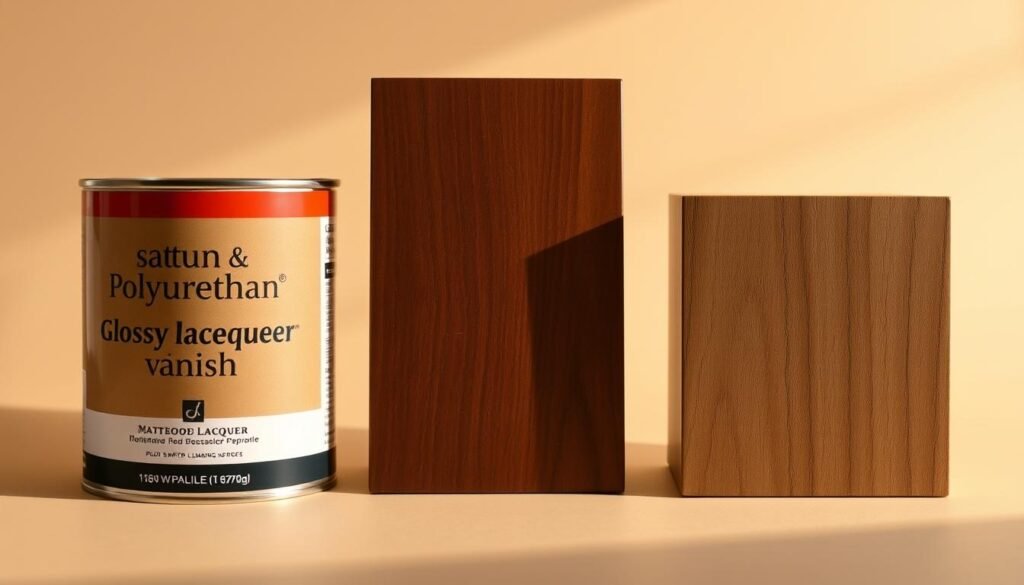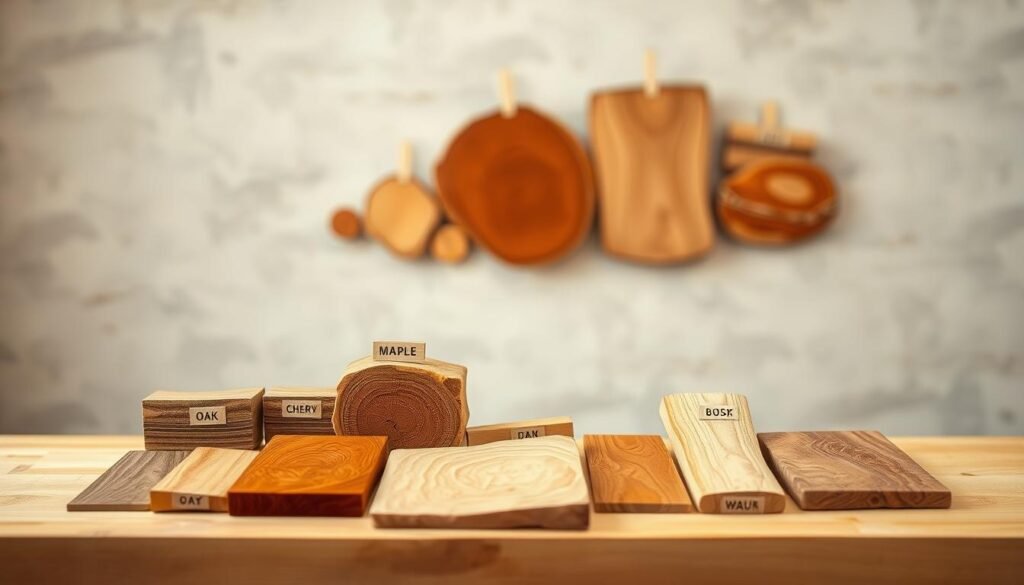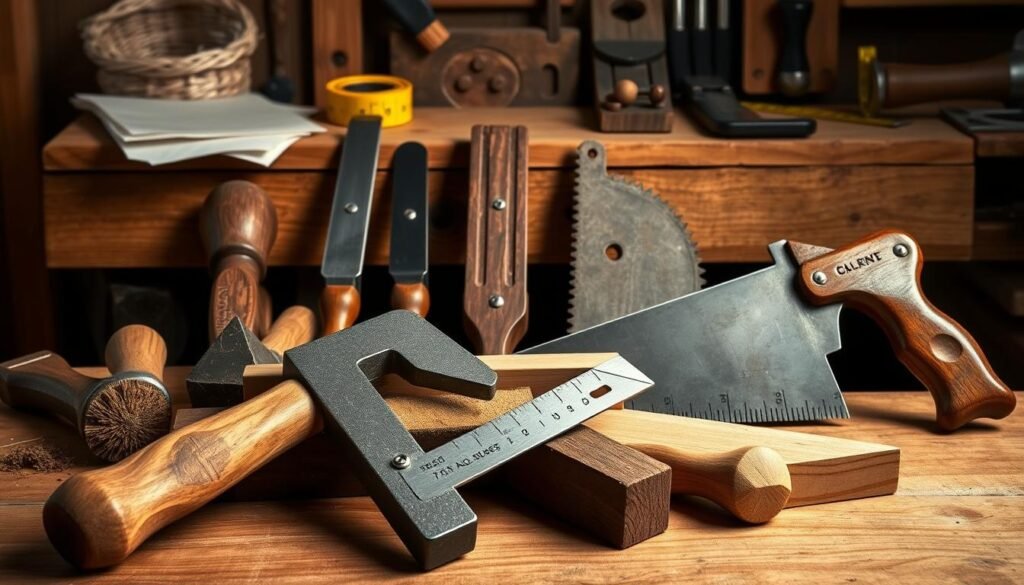Turning your living space into a stylish and functional haven is possible with woodworking. It’s a great way to go beyond the usual decor. Learning woodworking skills can change the game for you.
DIY woodworking projects let you add a personal touch to your decor. You can make pieces that are not just beautiful but also hold meaning. This article is here to help you, whether you’re starting out or looking for inspiration.
We’ll cover everything from simple projects for beginners to more complex designs. You’ll learn tips and ideas to master woodworking. This will take your home decor to the next level.
The Art of Woodworking for Home Decor
Woodworking lets people make custom decor that shows their style. With the right tools and techniques, homeowners can make unique items. These items can make their homes look better.
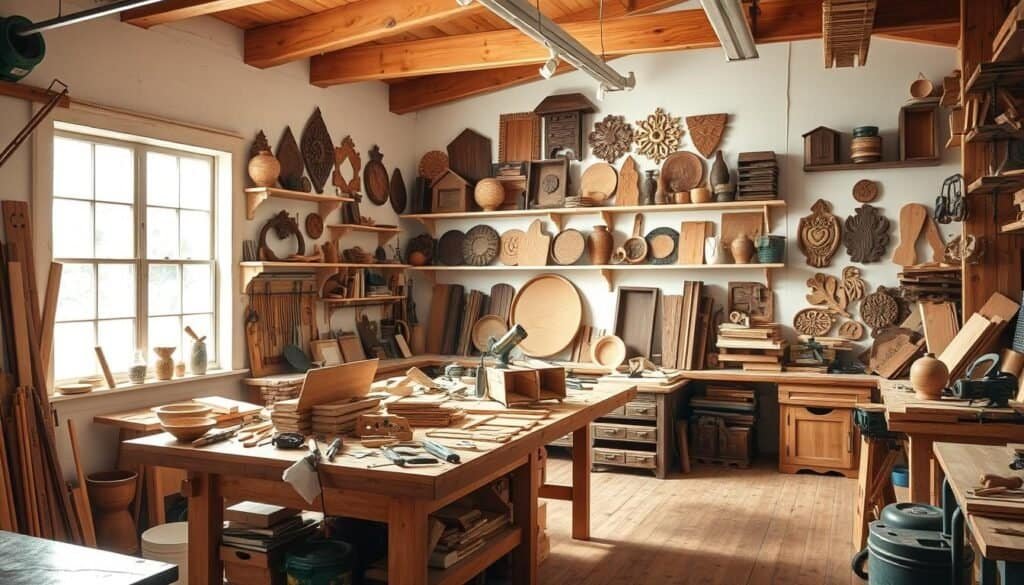
Woodworking for home decor has big advantages. It lets you make decor that fits your space and taste perfectly. This is different from store-bought decor, which might not fit as well.
Benefits of Custom-Made vs. Store-Bought Decor
Custom decor fits perfectly and matches your style. It’s made with specific materials and finishes. This makes it last longer and look better.
Store-bought decor is made in large numbers. It often lacks a personal touch. Woodworking lets you create decor that shows your personality and makes your home special.
If you want to improve your home with woodworking, there are helpful tips. These tips can guide you in picking the right wood and designing your project. They help you do a great job.
Essential Woodworking Tools Every Beginner Needs
Woodworking is a world full of excitement and challenges. Beginners can start strong with the right tools. It’s a craft that needs precision, patience, and the right gear.
For beginners, it’s easy to feel lost with all the tools out there. But, starting with the basics is the best approach. Essential tools are the foundation for tasks like measuring, cutting, shaping, and assembling.
Must-Have Measuring and Marking Tools
Measuring and marking tools are key for accuracy in woodworking. A quality tape measure is essential for measuring lengths and widths. A combination square is also vital for checking squareness and marking precise angles.
Marking gauges are important for making consistent and accurate marks on wood. They help in creating repeatable joints and ensure your projects are well-aligned.
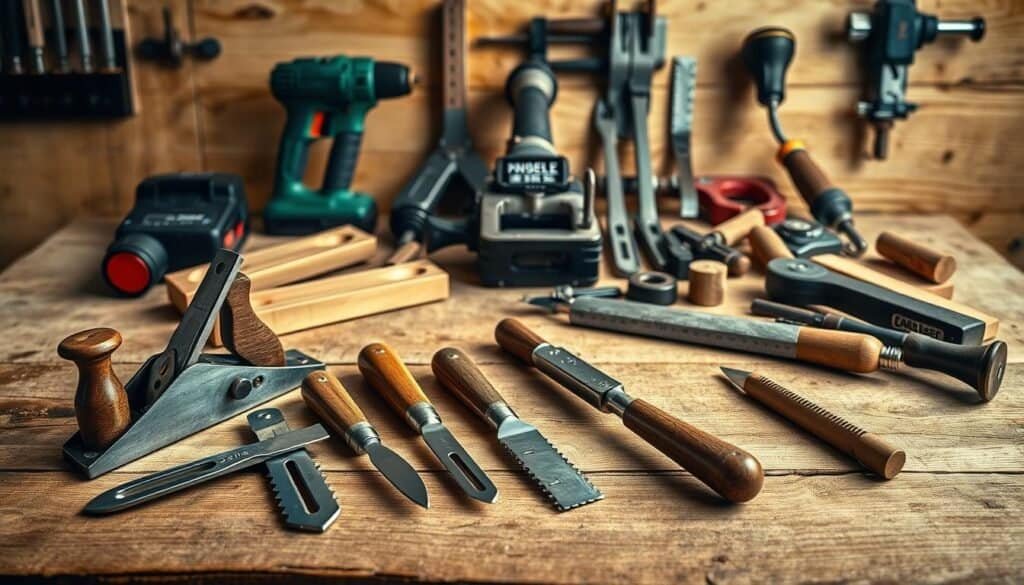
Other essential tools for beginners include chisels, hand saws, and mallets. These tools are basic for tasks like cutting, shaping, and assembling projects.
Creating a list of woodworking tools is helpful for beginners. It’s also wise to invest in quality tools that will last, not the cheapest ones.
By focusing on essential tools and understanding their uses, beginners can lay a strong foundation. This improves their skills and makes their projects enjoyable and rewarding.
Understanding Wood Types and Their Best Uses
Woodworking fans know picking the right wood is key. There are many types of wood, each with its own traits. Knowing which wood to use is vital for any project.
Wood is divided into hardwoods and softwoods. Hardwoods, like oak and maple, are strong and often used for furniture and floors. Softwoods, such as pine and cedar, are softer and cheaper, great for building and outdoor projects.
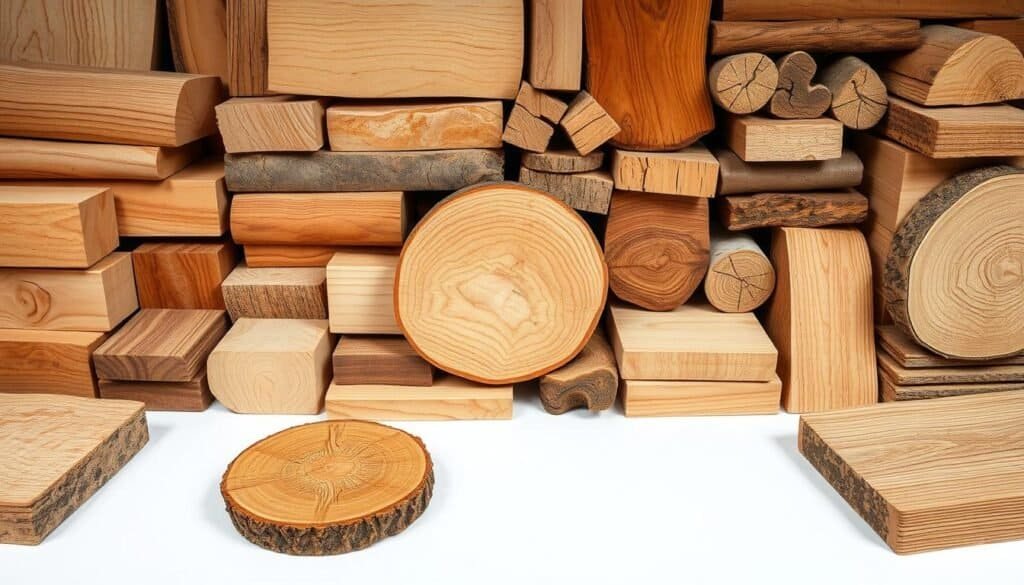
The wood’s grain, color, and how it handles moisture also matter. For example, woods with unique grain patterns can make a project look better. Woods that resist moisture well are best for outside use.
Knowing how to match wood characteristics with project needs is important. Cherry and walnut are favorites for furniture because of their rich colors and fine grains. For outdoor projects, cedar and cypress are top choices for fighting rot and bugs.
Choosing the right wood ensures your woodworking projects succeed. Your creations will be both useful and beautiful.
Fundamental Woodworking Techniques for Beginners
Fundamental woodworking techniques are key for beginners to improve their skills. Learning these basics is essential for making beautiful and useful items. These items can make any home look better.
Sanding is a critical technique in woodworking. It smooths out wood surfaces, removes flaws, and gets the wood ready for finishing. The progressive grit sanding method is very effective.
Progressive Grit Sanding Method
The progressive grit sanding method uses finer grits of sandpaper to smooth out wood. It removes scratches and flaws gradually. Start with a coarse grit (80-100) to remove big flaws, then use finer grits (120-150, 220, etc.) for a smooth finish.
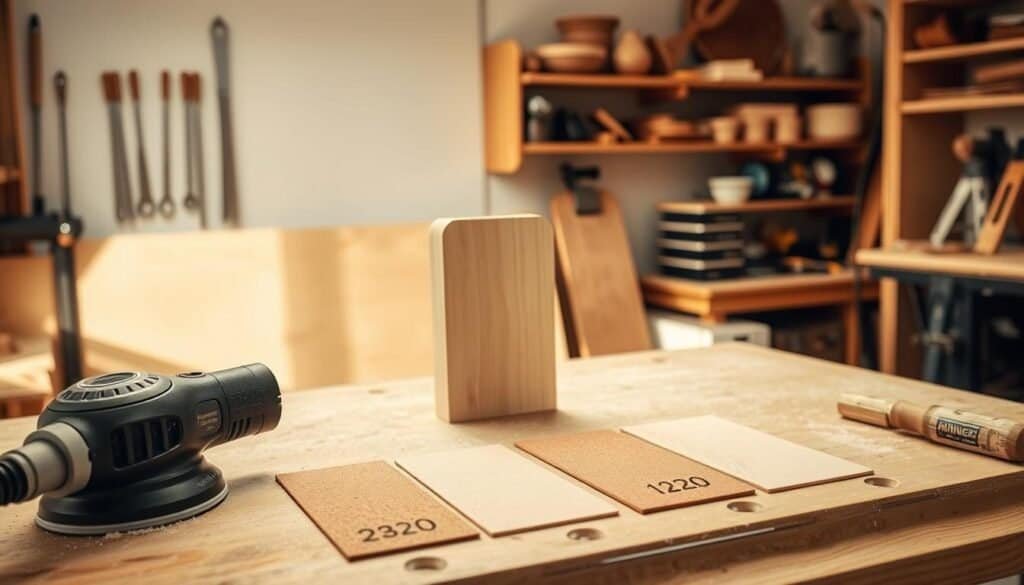
Other important techniques include measuring and cutting accurately, using the right joinery methods, and applying finishes correctly. Beginners should practice these to get better and more confident.
By mastering these basic techniques, beginners can prepare for more complex projects. As you get better, you’ll be able to make amazing pieces for your home.
Mastering Basic Wood Joinery Methods
Wood joinery is key in woodworking, adding strength and beauty to projects. It makes a piece go from simple to stunning. Learning basic wood joinery methods is vital for making durable, beautiful furniture.
There are many types of wood joinery, each with its own uses. You’ll find dovetail, mortise and tenon, dado, and butt joints. Knowing when to use each is important for your woodworking success.
When to Use Different Joinery Types
The right joinery depends on your project’s needs. This includes the wood type, design, and how you’ll use the piece. For instance, dovetail joints are great for drawers because they’re strong against pull-out forces.
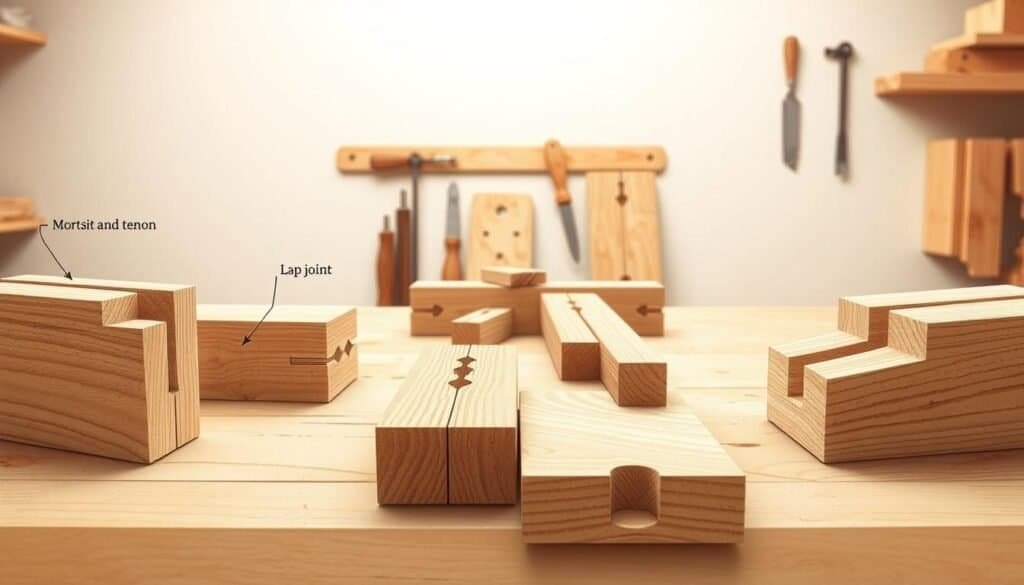
Mortise and tenon joints are versatile, used in frames and furniture. Dado joints are perfect for shelving, making assembly easy and providing strong shelf support.
Butt joints are simple but work well for many projects. Yet, they might need nails or screws for extra strength.
By learning these basic wood joinery methods and knowing when to use them, you’ll boost your woodworking skills. Your projects will be both useful and beautiful.
Woodworking Knowledge Every Home Decor Enthuasiast Should Learn
Being a home decor enthusiast means you can take your DIY projects to the next level. Learning woodworking basics lets you make custom pieces that show off your style. This way, you can make your home truly yours.
Understanding different types of wood is key in woodworking. Oak is strong and great for furniture, while pine is softer and perfect for decorations. Knowing this helps you pick the right wood for your projects.
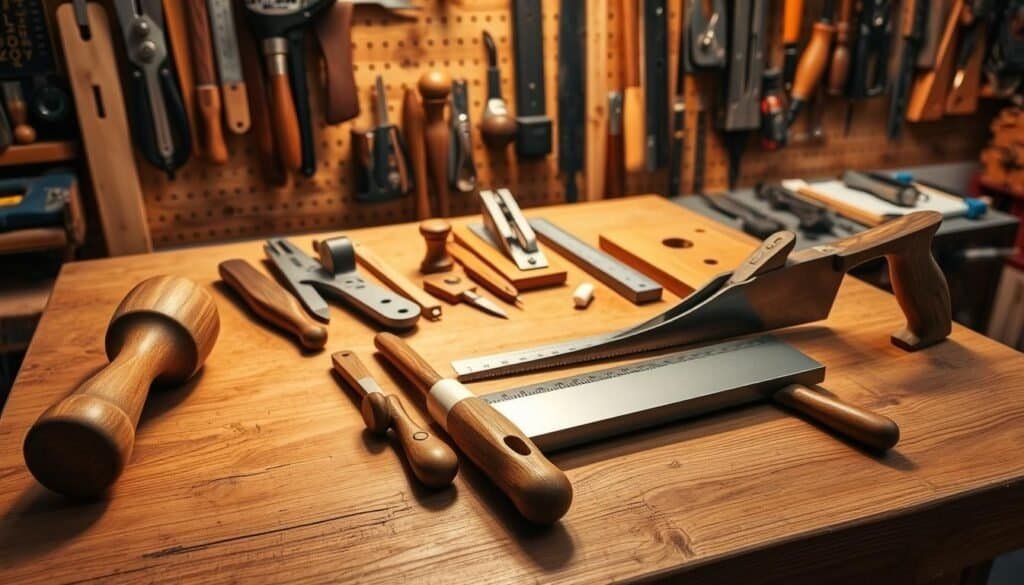
DIY woodworking projects can be simple or complex, depending on your skill. Beginners can start with easy tasks like making a coat rack or a picture frame. As you get better, you can tackle more challenging projects, like making furniture or decorations.
For creative ideas, check out online tutorials, woodworking books, and home decor magazines. You can also try new techniques, like distressing or staining, to make your projects stand out.
Woodworking opens up a world of creativity for home decor enthusiasts. It lets you make both functional and decorative items. This way, you can make your living space even more special.
Simple Woodworking Projects to Beautify Your Home
Make your living space special with simple woodworking projects. They add a personal touch, whether you’re new or skilled. Many projects can improve your home’s look without taking too much time or money.
Woodworking lets you make something beautiful and useful in just a weekend. Try making a wooden coat rack, a reclaimed wood shelf, or a wooden mirror frame. These projects can greatly change your home’s look.
Weekend Projects That Make Big Impact
Start with a wooden planter box. It’s a great way to bring greenery into your home and practice your skills. You can make it any size or design to match your space and style.
Building a wooden headboard is another good idea. It’s a simple project that can add elegance to your bedroom. Pick the wood and design that fits your decor.
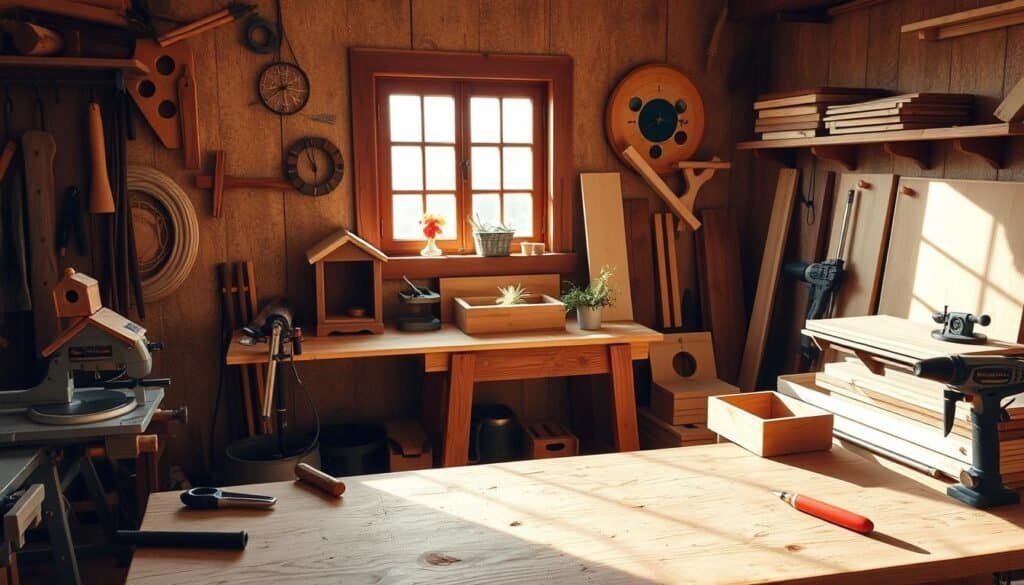
If you’re up for a challenge, try making a wooden room divider. It’s a stylish and functional addition to any room. You can add shelves, cabinets, or keep it simple, based on your skill and needs.
These woodworking projects not only make your home look better but also give you a sense of pride. They’re great for anyone starting or continuing their woodworking journey. They offer a chance to create something unique and personal.
Creative Finishing Techniques to Elevate Your Projects
Finishing techniques are key to turning a simple woodworking project into a masterpiece. The right finish can make the wood look better, protect it, and give your work a professional look.
Choosing the right finish is very important. The type of wood and how you plan to use your project will help decide the best finish. For example, a dining table needs a strong finish, while a wall shelf might not.
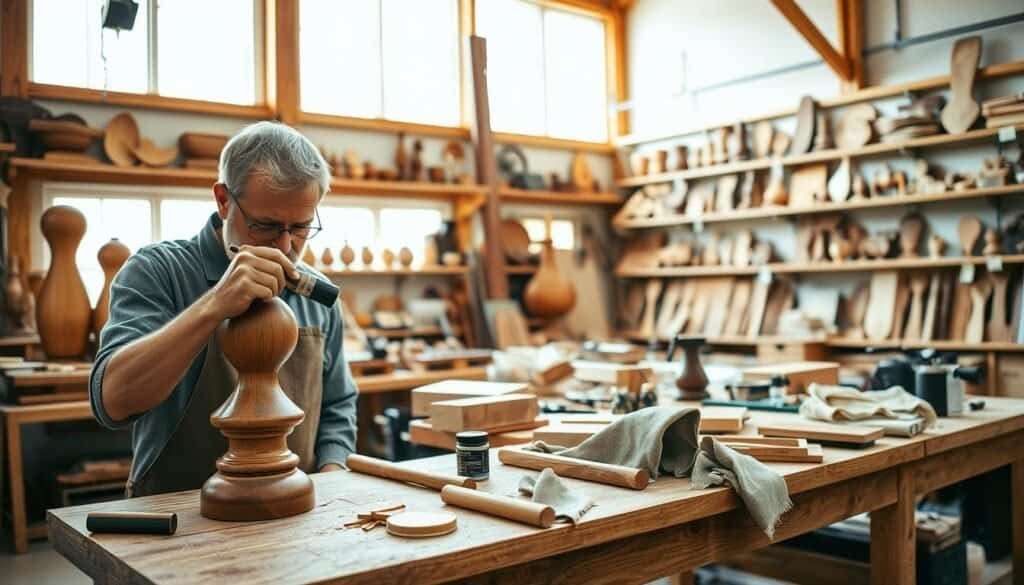
Applying a protective topcoat is a must in finishing. It makes your project look better and keeps the wood safe from damage. Polyurethane, varnish, and lacquer are top picks for protective finishes, each with its own shine and durability.
When you apply a protective topcoat, follow the instructions carefully. Use thin, even coats, letting each dry before adding the next. This way, you get a smooth, lasting finish.
Other creative finishes include staining, painting, and distressing. These add character and make your projects stand out. Trying different techniques can help you find your own style and improve your woodworking.
By learning creative finishing techniques and the importance of protective topcoats, your woodworking projects will be both beautiful and durable. Whether it’s furniture or decorative items, the right finish can make a big difference.
Space-Saving Woodworking Projects for Small Homes
Woodworking can make a small home cozy and inviting. With creativity, you can make pieces that save space and add warmth. These pieces can also bring character to your home.
Maximizing storage is key in small homes. Space-saving woodworking projects help by providing smart storage solutions. You can make wall-mounted shelves, foldable tables, or hidden storage. These keep your things organized and out of sight.
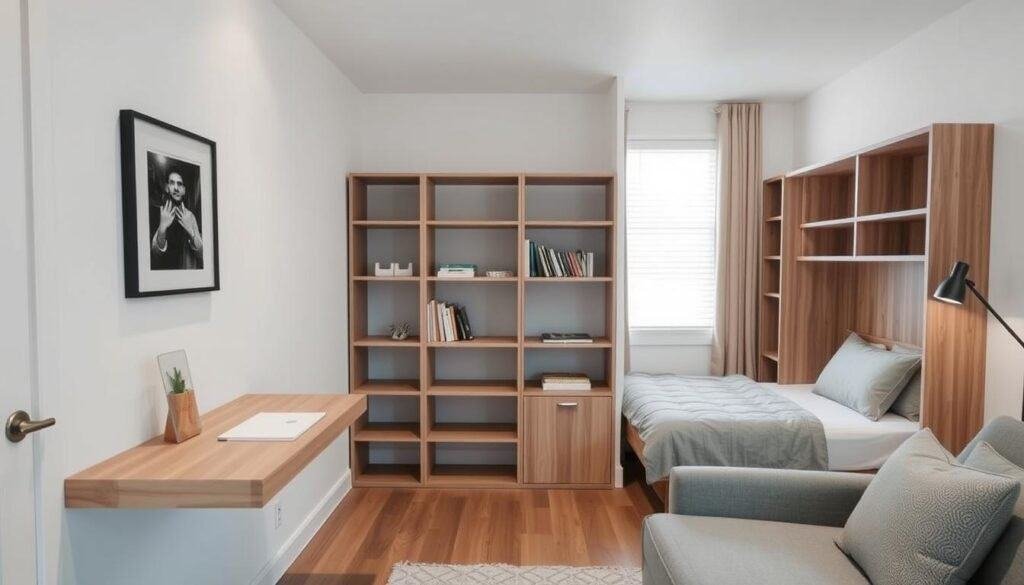
Woodworking in small spaces means being creative with what you have. Think about making pieces that do more than one thing. For example, a storage ottoman or a coffee table with storage. These ideas save space and add function to your home.
DIY home decor projects are fun and rewarding. They let you personalize your space. By picking the right projects, you can make your home feel bigger. Plus, it shows off your style. Whether you’re experienced or new to woodworking, there are many projects to try.
In summary, space-saving woodworking projects are great for small homes. They help create a home that’s both beautiful and functional. With a bit of creativity, even the smallest spaces can become a cozy haven.
Upcycling and Repurposing Wood for Sustainable Decor
Upcycling and repurposing wood for home decor is becoming more popular. It’s a sustainable and creative way to decorate. It reduces waste and adds a personal touch to your home.
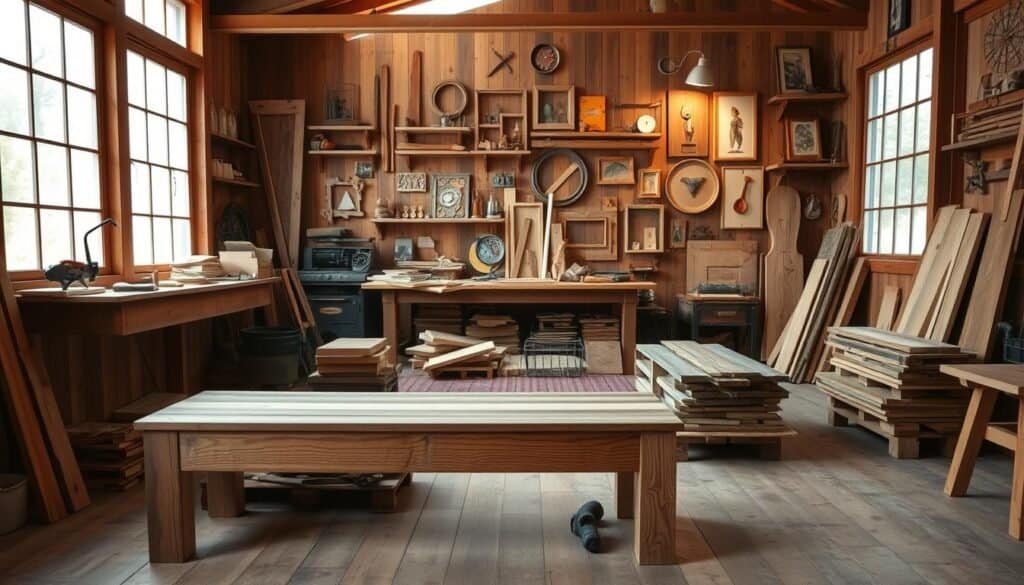
Upcycling wood means turning old or discarded wood into new items. You can make coffee tables from old pallets or shelving from reclaimed timber. The goal is to find value in items others might throw away.
Identifying Good Candidates for Upcycling
Not all wood is right for upcycling. Look for sturdy wood with a nice grain pattern. Old furniture, wooden crates, and reclaimed wood from demolition sites work well. Check the wood for rot or damage before upcycling.
Repurposing wood saves money and creates something unique. Each piece has a story, adding character to your home. It’s also a step towards living sustainably, reducing the need for new lumber and waste.
To start upcycling wood, you’ll need basic tools and creativity. Begin with simple projects and then tackle more complex ones. It’s rewarding and a great way to make your home eco-friendly.
Building a Functional Home Workshop on Any Budget
Creating a home workshop doesn’t have to cost a lot. With some planning and creativity, you can make a space that’s both organized and meets your woodworking needs. This can be done without spending too much.
Start by looking at the space you have. It could be a whole room, a garage corner, or a basement section. Knowing your space limits is key. Measure it and plan your layout carefully. Think about the “work triangle” idea, where your main stations are close together for better efficiency.
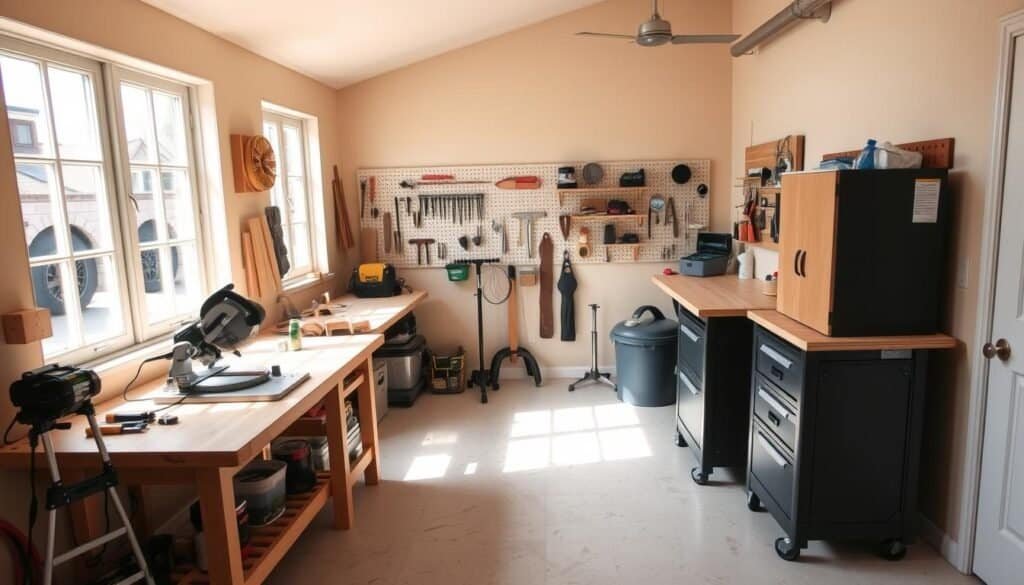
When space is tight, make your layout work for you. Use wall-mounted storage like pegboards, hooks, and shelves to keep tools organized. Also, get mobile workstations and tool carts to save space and be more flexible.
Focus on the tools you really need first. Add more as you get better at woodworking. Look for second-hand or refurbished tools to save money. Also, make sure your workshop is well-lit and has good air flow for safety and comfort.
With smart planning and resourcefulness, you can build a home workshop that fits your budget. Emphasize organization, efficiency, and safety to get the most out of your space.
Time-Saving Woodworking Jigs and Fixtures
Understanding jigs and fixtures is key to making your woodworking faster and more accurate. These tools help you work smarter, not harder. They make complex tasks easier and help you get professional results.
Woodworking jigs guide your tools for precise cuts or joints. They’re great for tasks you do over and over. Fixtures, on the other hand, keep your workpiece steady while you cut or shape it.
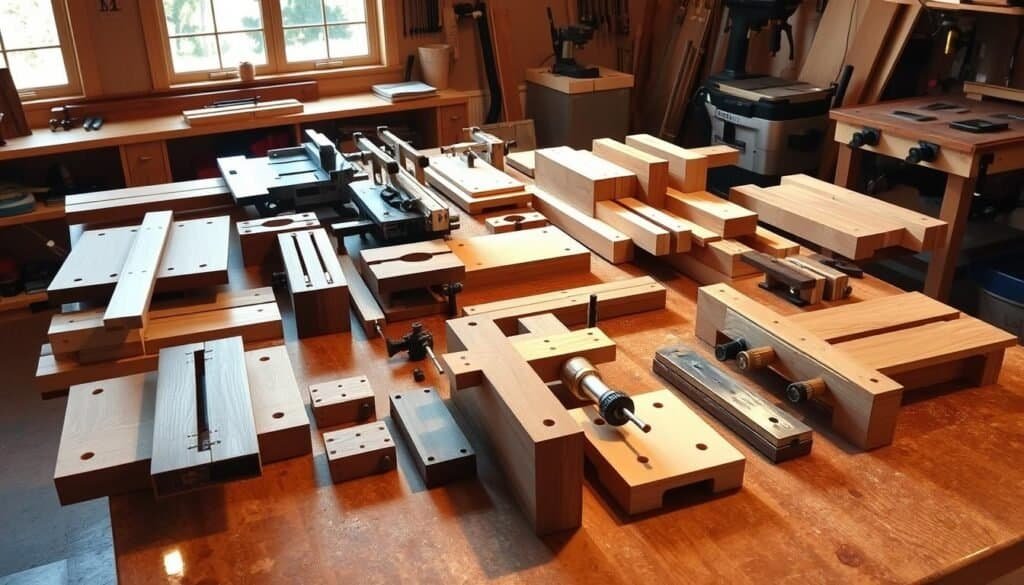
The crosscut sled is a must-have for woodworkers. It makes accurate crosscuts easy, ensuring your pieces are the right length. Building one might seem hard, but it’s actually simple and boosts your skills a lot.
Building Your First Crosscut Sled
To make a crosscut sled, start with a plywood or MDF base. Add a fence that’s square to your cuts. Then, put runners on the sled for your table saw’s miter slots. Finish with a stop block on the fence for consistent cuts.
Using jigs and fixtures like the crosscut sled makes your woodworking faster and better. These tools are vital for anyone wanting to improve their woodworking skills.
Troubleshooting Common Woodworking Problems
Troubleshooting is key for woodworkers at any level. Even with careful planning, problems can pop up. You need knowledge, patience, and creativity to fix them.
Warped or uneven wood is a common issue. It often happens due to bad storage or humidity changes. To avoid this, store wood right and let it adjust to your workshop’s climate before using it.
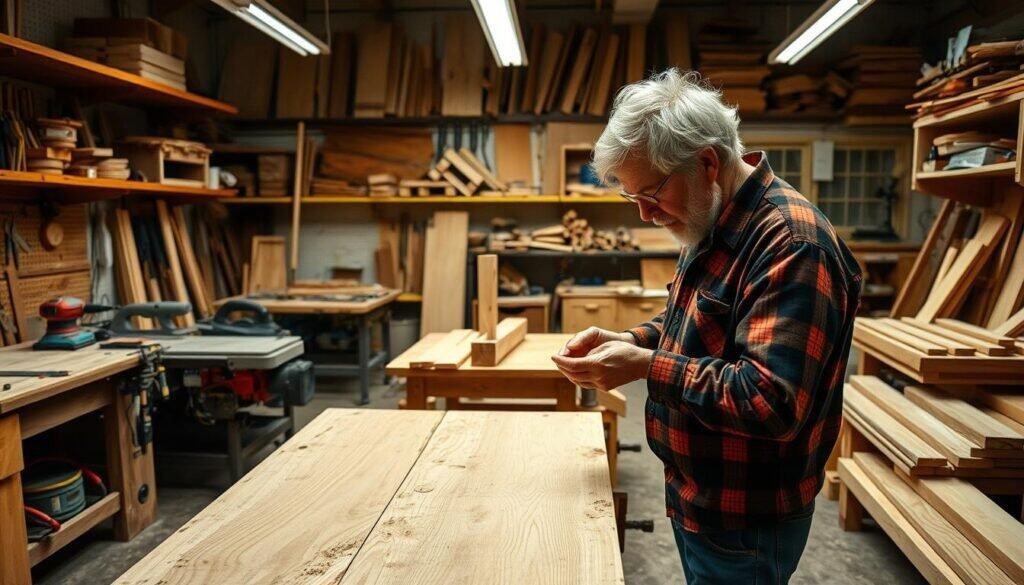
Misaligned joints are another big problem. They can weaken a piece’s structure. To avoid this, measure accurately and use the right joinery methods. If a joint is off, figure out the best fix.
When to Save a Project and When to Start Over
Deciding to fix or redo a project is tough. Consider how bad the problem is, the project’s state, and the time you’ve spent. Sometimes, fixing a project can be a fun challenge. Other times, it’s smarter to start fresh.
Knowing when to give up and when to keep going is important. For small problems, fixing them can teach you a lot. But if a project is seriously wrong or can’t be fixed, starting over might be better. You’ll learn from your mistakes and do better next time.
Conclusion: Your Journey to Woodworking Mastery
Starting a woodworking journey is rewarding for anyone who loves home decor. With the right tools, skills, and knowledge, you can make beautiful DIY projects. These projects can make your home look amazing.
We’ve looked at important woodworking tools, basic techniques, and creative ways to finish projects. We’ve also talked about simple projects, saving space, and eco-friendly practices. These tips will help you begin your woodworking journey.
Keep practicing and be patient as you work on your projects. Don’t worry about mistakes at first. They’re chances to learn and get better. With hard work and dedication, you’ll soon be making beautiful DIY projects.
Woodworking is exciting for both newbies and experienced woodworkers. It lets you be creative and express yourself. So, pick up your tools, think creatively, and start making the home decor you dream of.

